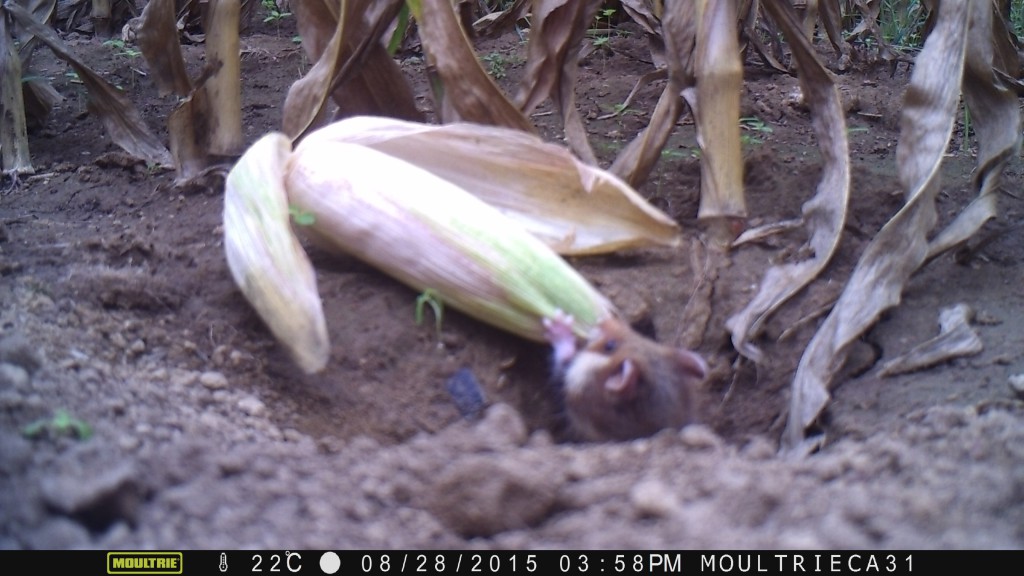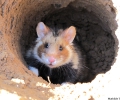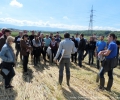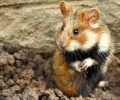Decline of the hamster in Alsace, response strategies…
7 septembre 2016On 19 April 2016, CNRS [French national scientific research centre] and the French national office of hunting and wild fauna (ONCFS), published a study into intensive maize farming and climate change on the impact of European Hamster (Cricetus cricetus)* demographics in Nature Scientific Reports.
This study reported a decline of more than 21% in the body weight of the European Hamster population over the Alsace plain in a century.
How is such a large weight loss explained?
Weight loss in a population can be explained in two ways:
- either the animals are getting thinner,
- or the animals have shorter lives and the population consists of ever younger, and therefore lighter, animals.
In the Alsace, whatever the situation, the deterioration in the hamsters’ living environment would be under scrutiny.
The researchers were actually able to demonstrate the link between the increase in winter rainfall (due to climate change) and the drop in hamsters’ body weight as they emerge from hibernation. The same is true with the expansion of maize monoculture over recent decades, which also has a negative impact of the weight of the animals.
There is a negative correlation between last year’s graphs for the body weight of hamsters emerging from hibernation and those for the ‘maize production and cultivated area’. The years following those with high maize production (e.g. 1993-1994 and 2012-2013), the researchers saw a drop in the hamsters’ body weight.
(‘maize yield’ means both ‘production and cultivated area’)
What can we deduce from this?
- the increase in maize monoculture over large surface areas leads the animal to store only maize to pass the winter. This lack of nutritional diversity does not allow it to be in good physical condition in the spring.
- differences in temperature and humidity of the soil between maize fields (where the soil is left bare in winter) and cultivated fields (e.g. winter wheat, where crops are growing throughout the hibernation period) create less favourable conditions and greater weight loss in the hamsters.
- increasing winter rainfall could cause deterioration of food stored in the burrow and/or increase cold felt by the animal. The hamster would then have to warm itself more, a costly process in terms of energy that could result in weight loss, all the greater if it has no more edible food in its burrow.
And what outcome for the hamster population in the Alsace?
The animals’ body weight is a critical factor for its reproduction. Animals that are too thin reproduce less successfully, which would lead irremediably to a reduction in the population.
How can it be remedied?
This observation provides very important information for understanding the causes of the European Hamster’s disappearance and finding long-lasting solutions.
Food supply is an essential aspect of conserving the species.
CNRS is now examining mechanisms that could be used to explain these observations in more detail and validate them in the field through tests carried out jointly with the Chamber of Agriculture and farmers.
These are tests based on crops in addition to maize, the aim being to identify crops beneficial to the hamster, as well as being technically and economically interesting to the farmer. This would ultimately make it possible to increase the hamster population in the Alsace and could be extended over its entire, currently threatened area of distribution.
* Tissier ML, Handrich Y, Robin JP, Weitten M, Pevet P, Kourkgy C, Habold C (2016).
How maize monoculture and increasing winter rainfall have brought the hibernating European hamster to the verge of extinction. Scientific Reports (6 May 2016) 6, article no. 25531. doi: 10.1038/srep25531.
http://www.nature.com/articles/srep25531






